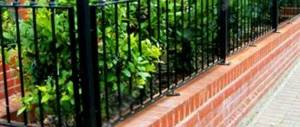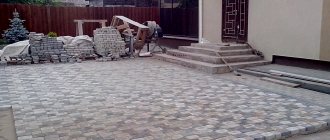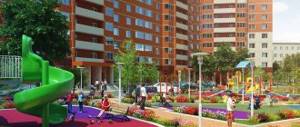Almost every major settlement has problems with parking spaces. Many residents are faced with the fact that other people’s vehicles are parked on the territory of their apartment building, and not always correctly, which can impede traffic. To prevent such situations, residents decide to erect a barrier in their local area.
Dear readers! The article talks about typical ways to resolve legal issues, but each case is individual. If you want to find out how to solve your particular problem , contact a consultant:
8 (800) 700 95 53
APPLICATIONS AND CALLS ARE ACCEPTED 24/7 and 7 days a week.
It's fast and FREE !
The law does not prohibit such an action, but the installation must be carried out in compliance with established standards and requirements with prior permission from the relevant authorities.
General information
When deciding to install a barrier on the territory of an apartment building, the following requirements must be met:
- the plot of land on which the house is located must be privatized;
- the decision on installation is made at a general meeting of residents;
- At least 2/3 of the votes must be collected;
- it is necessary to develop a special project, which must indicate that special vehicles (fire trucks, ambulances, etc.) can freely enter the territory;
- Before starting work on installing the barrier, you will need to obtain permission from various authorities.
The installation procedure requires significant financial costs. When new residents move into the house who did not take part in the voting, they are not charged for the maintenance of the barrier.
Types of barriers and their choice
If there is a need to restrict entry into the courtyard of a residential building, barriers have many advantages over other means of restricting the road. They imply practicality, efficiency and ease of installation and subsequent operation, regardless of what type of drive is used.
Barriers are divided into two main types. The choice is determined by factors such as the intensity of traffic flow and the requirements for the limiting structure itself.
Mechanical option
A mechanical barrier is an inexpensive option, but it is worth considering that all manipulations are carried out manually, which requires the constant presence of a worker on site.
Alternatively, the car owner can open the passage himself, drive into the yard and close the barrier behind him. But this is not entirely convenient, and you have to waste time. Based on the opening principle, mechanical devices are divided into vertical, horizontal and individual parking devices . To restrict entry into the local area, the latter are most often used. The production of such barriers is carried out to order, they are installed by concreting or fastening to anchor bolts, and are closed with a padlock. They are very light and compact, so the process of installation and dismantling is not difficult at all.
Automatic option
Automatic barriers are highly functional, durable, convenient and have a modern appearance. Their characteristics vary in such parameters as drive type (hydraulic or electromechanical) and operating speed:
- Barriers with a hydraulic drive type do not fail even in severe frost, since special frost-resistant substances are used for operation. Otherwise, the technical characteristics of both drives are in no way inferior to each other.
- Automatically controlled barriers operate from a common network. They are controlled via a radio channel, keyboard, button, proxy card, and it is also possible to connect the function to a mobile phone. If for any reason the power supply is interrupted, they can be controlled manually.
Before choosing a suitable fence, it is important to first determine the functions it should perform. The purchase of high-intensity devices is justified only when a barrier is required for a parking lot with a large traffic flow. If the parking lot is small, an intensity level of less than 80 percent is fine.
It is important to know that the speed of operation is affected by the length of the barrier boom. If the entrance to the yard is wide enough, it makes sense to purchase a limiting system with two booms on both sides, this will increase the speed of closing/opening.
As for the control option, it must be selected based on whether it is expected that there will be a watchman in the house or whether the option of opening it independently is possible.
The barrier can be equipped with LED lamps, a signal, lighting and other elements that increase its operational properties. The more efficient the limiting system is, the more equipped it is with auxiliary functions, the higher the price of the structure. Thus, residents independently decide how much they are willing to pay for the safety and quality of the device.
Legal regulation
Housing legislation indicates that the adjacent territory belongs to the shared ownership of the owners of residential apartments in the building. This means that decisions regarding the disposition of the common area must be agreed upon at a meeting.
When deciding to install a barrier on the territory of an apartment building, owners should be guided by:
- Article 26 of the Land Code of the Russian Federation;
- RF LC in terms of articles 16, 36, 44 and 46;
- clause 1.5 of the traffic rules.
Only taking into account the specified rules and regulations can the installation of a barrier be carried out. According to the law, it is necessary to obtain permission from individual authorities, which include the fire inspectorate, local administration and housing department.
It is legal?
Our legislation allows the installation of barriers, since the courtyard area is part of the common property of the owners living here, and the owners can improve it at their own discretion.
Clause 4 of Part 1 of Article 36 of the RF Housing Code:
The owners of premises in an apartment building own, by right of common shared ownership, the common property in the apartment building, namely: ... the land plot on which this house is located, with elements of landscaping and landscaping, other intended for the maintenance, operation and improvement of this house and located on the specified land plot objects. The boundaries and size of the land plot on which the apartment building is located are determined in accordance with the requirements of land legislation and legislation on urban planning.
But, of course, there is no need to act without permission, it is punishable. A collective decision of the owners and coordination of the installation with several authorities will be required, which we will discuss below.
How to install a barrier in the courtyard of an apartment building?
When the yard is open to the passage of any vehicle, it is inconvenient and unsafe, since children and elderly people often walk in the area. How legal is it to install a barrier, and what rules must be followed?
Is it legal?
Any restrictions on entry into the territory of an apartment building impede the movement of special services, such as firefighters, ambulance, police, etc. Without a positive decision from the special services, the installation of a barrier will be equated to unauthorized actions, entailing the imposition of penalties under Article 20.4 of the Code of Administrative Offenses of the Russian Federation.
A separate legislative act regulating the issue of installation has not been developed, therefore the rules for using the common territory of the house should be taken into account.
The decision on installation is made at a general meeting of residents, as stated in Article 44 of the Housing Code of the Russian Federation.
To isolate yourself from problems - put a barrier in the yard
The area near the high-rise building is a functional space.
It carries aesthetic significance, greeting us with well-groomed flower beds, serving as a parking lot, a place for gatherings with neighbors, and a playground for children to play and walk. It turns out that the yard is no less important than the apartment. And in a large city, from the point of view of safety and convenience, it often requires even more attention.
Alexander, marketing specialist: “I live in Moscow, near the Lermontovsky Prospekt metro station. In 2014, I learned from neighbors about a tragic story that happened in broad daylight. Our house is located not far from the highway, and while the passage was open, cars constantly avoided traffic jams through our yard. Some drivers in a hurry did not even slow down. One such driver hit a child who went for a walk on the playground. Of course, the situation caused a wave of indignation among residents, and we installed a barrier.”
From what our colleague said, a sad conclusion suggests itself: people begin to act only when something bad happens. Analyze the situation in your yard and take care of yourself and others by initiating the installation of a barrier. This will make life safer.
The safety of children is a paramount issue. But there are others, although less important, that affect our comfort. For example, everyone wants to be sure that when they arrive home in the evening, they will have somewhere to park their car. And preferably not three kilometers from your own yard.
For residents of houses located near business centers with paid parking, this is a real headache. When coming to work, “outsiders” from other areas save money by leaving their cars in the yard for free. Thus, they occupy the territory, depriving residents of parking spaces.
The problems are obvious, and the solution is to prohibit entry into the courtyard for everyone except residents and special services. Then the question arises about the barrier, which in its purpose is similar to the lock on the apartment door and the intercom on the door to the entrance.
Rules
The basic rules regarding the installation of barriers in 2020 include:
- ownership of the local area is registered;
- at a meeting of residents, a decision is made to install a barrier and put it into operation;
- an installation estimate is developed and approved, which specifies all the details regarding the device and its technical characteristics;
- an application is submitted to the municipal authority with a protocol attached and permissions obtained in advance from regulatory services;
- After receiving all permits, installation work can begin.
The procedure for installing a barrier in the courtyard of an apartment building includes the following:
- The barrier is placed so as not to interfere with the passage of citizens; free movement must be maintained for all categories of pedestrians, including parents with strollers, people with disabilities, cyclists, etc.
- Emergency services must have free entry into the territory.
- The boom of the device is made of lightweight material.
- During installation, safety elements during its operation must be provided.
- The stand and boom holder are mounted on a concrete surface to ensure the stability of the structure.
The period for registering an apartment building with cadastral registration is determined by current laws. What is the time frame for replacing an elevator in an apartment building? See here.
What are the requirements?
The path to the yard must always be accessible, this is precisely what Article 23 of the PPB indicates, which gives the fire inspectorate the right to prohibit equipping the yard with a barrier. The same rules are found in the requirements of urban planning legislation (SNiP 2.07.01-89).
From the edge of the train to the wall of a residential building, a distance of 5-8 meters should be maintained if the height of the house is 10 floors, with a higher number of floors - a distance of 8-10 meters.
As for fire requirements, attention should be paid to the following point - if the device prevents fire engines from accessing the house, then when they are called, the fire department must be notified of this circumstance.
To ensure access to the entrance around the clock and to avoid any questions from various authorities, a 24-hour service point should be installed at the barrier or a dispatch service with a control panel should be installed nearby.
Approval procedure
In order to avoid dismantling the installation and imposing penalties on the residents of the house, all work activities should be coordinated with:
- public utilities;
- traffic police;
- fire service.
Obtaining permission from the final authority is the most difficult procedure, so it should be obtained as a matter of priority.
The fire official, as a rule, puts forward one requirement - fences should not interfere with the entry of fire trucks into the territory. If the rule is not followed, installation actions will be considered illegal.
Required documents
The documents you will need to prepare are:
- confirmation of registration of shared ownership of the residents of the house;
- an extract from the cadastre with complete information on the site;
- decision of a meeting of residents on the installation of equipment;
- developed technical documentation for the barrier;
- permission from the relevant authorities.
It is worth noting that this installation does not require a construction permit, since the device does not belong to a capital facility.
As an additional document, a traffic diagram for the local area may be required to confirm the absence of traffic violations.
Who is responsible for maintenance?
As a rule, to install such a complex structure as a barrier, a contractor is hired, which will subsequently maintain it for a fee.
The person involved in maintenance can be selected from among the residents of the house, but it should be remembered that he must have the necessary knowledge, since in the event of equipment breakdown and improper repair, problems may arise in its further operation.
On the procedure for installing a barrier in the local area of an apartment building
At the moment, the issue of restricting entry into the territory of apartment buildings has been brought under the control of the prosecutor's office due to the increasing number of cases of illegal installation of fences.
Many people install barriers without receiving official permission from the state fire inspection service, which is the main limiter in this matter.
In the event of an emergency (for example, a fire in a house) in an area illegally fenced with a barrier, special fire equipment will easily demolish the arrow on the route of the call, while residents will not receive compensation for the funds spent on installation (about 50 thousand rubles), since they acted without permission. And if a firefighter’s vehicle suffers body damage as a result of a ramming attack, then a claim may be filed against the initiators of the barrier installation for compensation for material damage.
According to Art. 36 of the Housing Code of the Russian Federation and Art. 16 of the Federal Law of December 29, 2004. No. 189-FZ “On the entry into force of the Housing Code of the Russian Federation”, the land plot on which an apartment building and other real estate objects included in such a building are located is the common shared property of the owners of the premises in the apartment building. The procedure for registering ownership of a land plot is established by paragraphs 2-5 of Art. 16 of the Federal Law of December 29, 2004. No. 189-FZ “On the implementation of the Housing Code of the Russian Federation.” The decision to form a land plot under the house is made by the owners of the premises at a general meeting. By decision of the general meeting of owners of premises in an apartment building, any person authorized by the said meeting has the right to apply to local government bodies with an application for the formation of the land plot on which the apartment building is located.
According to Art. 26 of the Land Code of the Russian Federation, ownership of a land plot is certified by documents in accordance with the Federal Law of July 21, 1997. No. 122-FZ “On state registration of rights to real estate and transactions with it.” In accordance with clause 1.5 of the Traffic Rules, it is prohibited to unauthorizedly install road signs, traffic lights, and other means of organizing traffic (including barriers) that interfere with traffic. The installation of a barrier must be permitted by the city administration in agreement with the state fire inspection service, the State Traffic Safety Inspectorate, and the public utility service.
Entry into the local area of vehicles of owners of premises in an apartment building and other persons is carried out in the manner established by the general meeting. This point must be included in the decision, as required by paragraph 6 of Moscow Government Resolution No. 428 “On the procedure for installing fences in local areas in the city of Moscow.”
The decision of the general meeting shall indicate information about the person authorized to represent the interests of the owners of premises in an apartment building on issues related to the installation of fencing devices and theirs.
According to Part 3 of Article 12 of the Moscow City Law “On Land Use in the City of Moscow” dated December 19, 2007 No. 48, the boundaries of land plots of apartment buildings are established on the basis of land surveying projects. The decision to prepare territorial planning projects, including a land surveying project, is made by the Committee on Architecture and Urban Planning of the city of Moscow. The owners of premises in an apartment building have the right to own and use this land plot to the extent necessary for their operation of the apartment building, as well as the objects that are part of the common property in such a building.
In accordance with the resolution of the Moscow government dated November 2, 2012 No. 614-PP, issues of the release of land plots from illegally placed objects on them that are not capital construction projects, including illegally installed fences, are carried out by permanent District Commissions for the suppression of unauthorized construction. Based on the decision of the district commission, the prefecture of the administrative district takes measures for the demolition and dismantling of non-permanent objects (fences, barriers).
By virtue of clause 2, part 2, article 44 of the Housing Code of the Russian Federation, the competence of the general meeting of owners of premises in an apartment building includes: making decisions on the limits of use of the land plot on which the apartment building is located, including the introduction of restrictions on its use. According to Part 1 of Article 46 of the Housing Code of the Russian Federation, decisions of the general meeting of owners of premises in an apartment building on issues put to vote are adopted by a majority vote of the total number of votes of the owners of premises in an apartment building participating in this meeting, with the exception of those provided for in paragraphs 1 - 3.1 of the part 2 of Article 44 of this Code of decisions that are adopted by a majority of at least two-thirds of the total number of votes of the owners of premises in an apartment building.
Thus, since installing a barrier in the courtyard of a house relates to the use of a land plot, including restricting the use of this plot, the general meeting of owners of premises in an apartment building (meeting of HOA members) has the right to decide to install a barrier in the courtyard of the house. However, such a decision must not be made by a simple majority of votes, but at least two-thirds of the total number of votes of the owners must vote for it, that is, a qualified majority.
In accordance with Part 5 of Article 46 of the Housing Code of the Russian Federation, the decision of the general meeting of owners of premises in an apartment building, adopted in the manner established by this Code, on issues within the competence of such a meeting, is mandatory for all owners of premises in an apartment building, including those owners who did not participate in the voting.
If the decision is made on an issue within the competence of the general meeting, that is, to install a barrier in the courtyard of the house, and in compliance with the requirements provided for by the Housing Code of the Russian Federation, then it also applies to the owner who did not take part in the vote or voted against the decision to installing a barrier. Consequently, this owner is obliged to pay for the installation of a barrier in the courtyard of the house.
If the decision is made in violation of the requirements stipulated by the Housing Code of the Russian Federation, that is, adopted by a simple majority of votes and not a qualified one (at least two-thirds of the votes), the owner who voted against such a decision has the right to appeal it in court.
In the event that subsequently one of the owners of the premises in this apartment building sold the apartment, the new owner is not subject to the decision of the general meeting of owners of the apartment building (general meeting of HOA members) regarding the payment of funds used to install the barrier in the yard Houses. These costs must be borne by the previous owner. The new owner may only be obligated to pay for the production of keys to the barrier if the previous owner did not give them to him. If the chairman of the house council (chairman of the HOA) refuses to hand over the keys to the barrier to the new owner, the new owner has the right to demand that the keys to the barrier be transferred to him in court on the basis of Article 304 of the Civil Code of the Russian Federation.
In accordance with this article, the owner may demand the elimination of any violations of his rights, even if these violations were not associated with deprivation of possession.
To summarize the above:
1. The first stage is a mandatory meeting of apartment owners, at which the issue of limiting entry into the yard by installing a barrier will be considered. If such a resolution is adopted by an overwhelming majority (preferably at least 70%) of the votes, then a protocol is drawn up. It is submitted to the relevant authorities.
If the local area is still communal property, a decision must be made on the formation of the site and its cadastral registration, and this requires the consent of all residents. But the decisions of full owners have great power.
2. A corresponding application, minutes of the meeting of tenants-owners and technical documentation, that is, a fencing project, are submitted to the municipal council of deputies. The council makes a decision no longer than a month (this is separately stipulated by law) and notifies the person who submitted the application about its decision no later than five days after the verdict is issued.
3. The decision will not necessarily be positive. A refusal, according to a government decree, can be obtained if round-the-clock unhindered passage and free movement of fire, gas, other emergency services and ambulance vehicles in the yard are not provided.
It is worth noting separately that barriers are dismantled if they interfere with territory improvement, construction (reconstruction) or major repairs carried out at the expense of the Moscow city budget. Dismantling will be announced in advance. In this case, the owners’ costs for the purchase and installation of the fencing device will be compensated. The amount of compensation is determined based on the independent assessment report.
According to Part 8 of Article 20.4 of the Code of the Russian Federation on Administrative Offences: “8. Violation of fire safety requirements for the provision of passages, passages and entrances to buildings, structures and structures - entails the imposition of an administrative fine on citizens in the amount of one thousand five hundred to two thousand rubles; for officials - from seven thousand to ten thousand rubles; for legal entities - from one hundred twenty thousand to one hundred fifty thousand rubles.”
SNiP 2.07.01-89 states that “when designing driveways and pedestrian paths, it is necessary to ensure the possibility of passage of fire trucks to residential and public buildings.”
According to the Code of Administrative Offenses of the City of Moscow (Article 6.5), liability is provided for restricting access to a free site. The maximum sanction for this violation in relation to legal entities is 20 thousand rubles.
Can they ban it?
The risk of failure to install a barrier always exists, or regulatory authorities may impose additional requirements. As a rule, the ban is imposed by the fire services. This is done for the safety of the residents of the house, so that in the event of an emergency, the necessary services can freely enter the territory of the house.
Read about carrying out major repairs of the common property of an apartment building. What are the rules for installing playgrounds near an apartment building? Information here.
Is there parking for disabled people in the courtyard of an apartment building? Details in this article.
Legal requirements
You must first familiarize yourself with the necessary list of legal acts.
The installation of a barrier in the local area or in the yard is regulated by the following laws of the Russian Federation:
- Housing Code in Art. 36 lists the range of common items for the residents of the house. Article 46 establishes the procedure for making decisions at a meeting of owners.
- Decree of the Government of the Russian Federation No. 491 of August 13, 2006 granted the right to jointly manage the courtyard territory.
- Land Code in Art. 26 indicates the presence of documents giving the right to dispose of the adjacent plot.
Conditions
Only if legal requirements are observed, the absence of sanctions from the authorities in the form of fines and dismantling is guaranteed.
It is important to consider the following rules:
- Construction of objects is permitted only on the territory of common shared ownership.
- Discussion of issues regarding the construction of a barrier is carried out only at a general house meeting by voting. For a decision to be made, at least 2/3 of the votes must be cast for it.
- It is necessary to first develop a special project that provides for the possibility of free passage of special vehicles.
Local Authority Requirements
It is important to take into account that there are no clear requirements at the federal level. It is worth paying attention to local acts that prescribe additional provisions.
Additional terms
It is not uncommon that, at the stage of agreement with the authorities, residents may receive a refusal, despite the existence of ownership rights to the site and other properly executed documents.
Circumstances preventing the construction of fences:
- In the absence of permission from technical services located in the local area.
- When blocking several entrances without the approval of interested parties.
What requirements are taken into account?
It is extremely important to study the basic requirements before carrying out the main actions.
These include:
- emergency services must be notified in advance about such an installation and have the opportunity to pass unhindered;
- the device should be located within a radius of 5-8 m from the house;
- A 24-hour service point should be installed nearby, equipped with an information board containing the telephone numbers of those persons who have a control panel and are able to open the passage.
Removing an illegally installed device
Installing a barrier in the courtyard of an apartment building is a small part of the matter; it is important that the work meets all requirements and rules. The residents of the house who are disturbed by it can also complain about the illegal installation of equipment. Such a complaint is submitted to the local administration.
Upon receipt of an application, an inspection is carried out with the involvement of employees of the traffic police and the Ministry of Emergency Situations, that is, those services that issue permission to install the fence.
Demolition of unauthorized installed equipment can be initiated without the participation of residents. For example, traffic police officers regularly check courtyard passages and if structures are found that impede passage, an order may be issued to dismantle the structure.
Illegal installation may result in a fine of up to 2,000 rubles for citizens and up to 150,000 rubles for legal entities.







